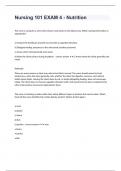Nursing 101 EXAM 4 - Nutrition
The nurse is caring for a client who refuses most foods on the dietary tray. Which nursing intervention is appropriate?
a) Contact the healthcare provider to prescribe an appetite stimulant.
b) Delegate feeding assistance to the unlicensed assistive personnel. c) Assess when client generally eats meals. d) Allow the client privacy during mealtime. - correct answer ✔✔c) Assess when the client generally eats
meals
Rationale:
There are many reasons a client may refuse food that is served. The nurse should assess for food preferences, when the client generally eats, whether the client has digestive concerns, and cultural beliefs about foods. Leaving the client alone to eat, or simply delegating feeding, does not encourage intake. The client does not need an appetite stimulant until a full assessment has been conducted and other interventions have been implemented. (less)
The nurse is teaching an older adult client about different types of proteins that can be eaten. Which food will the nurse identify that contain dietary protein? (Select all that apply.)
a) nuts
b) butter
c) beans
d) fish
e) poultry - correct answer ✔✔• nuts
• beans
• poultry
• fish Rationale:
Dietary proteins are obtained from animal and plant food sources, which include milk, meat, fish, poultry, eggs, soy, legumes (peas, beans, and peanuts), nuts, and components of grains. Butter is a fat and not a source of protein. (less)
A healthy, nonpregnant, nonlactating woman asks the nurse how many calories a day she should consume. Which response from the nurse is accurate?
a) 1,000 to 1,500 cal/day
b) 2,000 to 3,000 cal/day
c) 1,600 to 2,400 cal/day
d) 3,000 to 3,500 cal/day - correct answer ✔✔c) 1,600 to 2,400 cal/day
Rationale: The number of calories a person needs depends on age, body size, physical condition, and physical activity. On average, healthy adult women require 1,600 to 2,400 cal/day and adult men require 2,000 to
3,000 cal/day; the lower end of the range is for sedentary individuals, whereas the higher end is for active individuals (U.S. Department of Agriculture, 2010).
A nurse is working with a 46-year-old woman who is working to lose weight. Based on recommendations
from the USDA regarding diet modification, which is not appropriate advice for this client?
a) Make fruits and vegetables at least half of total food intake.
b) Drink juice for majority of fluid intake.
c) Eat a variety of enjoyable foods, but less quantity.
d) Drink nonfat or 1% milk. - correct answer ✔✔b) Drink juice for majority of fluid intake.
Rationale: Water should comprise the majority of fluid intake. The remainder should come from food sources such as fruit or 100% fruit juices.
A nurse has documented that a client has anorexia. What does this term mean? a) Fluid deficit b) Eating more than daily requirements c) Vitamin C deficiency d) Lack of appetite - correct answer ✔✔d) Lack of appetite
Rationale:
Anorexia is lack of appetite. It may be related to multiple factors, including diseases, psychosocial causes,
impaired ability to chew and taste, or inadequate income.
A 28-year-old woman client is in an outpatient clinic with frequent reports of fatigue. Her physician has prescribed her ferrous sulfate 325 mg to treat iron-deficiency anemia. A nurse is teaching the client about medication administration. What food would be best consumed with her ferrous sulfate? a) a can of soda pop b) a piece of bread c) a glass of milk d) a glass of orange juice - correct answer ✔✔d) a glass of orange juice
Rationale: Concurrent administration of vitamin C and iron helps with iron absorption. Orange juice is a common and inexpensive dietary source of vitamin C. A nurse is teaching a client about diabetes and glucose monitoring. What should the nurse include in the
teaching? a) Glucose levels will decrease with illness and stress.
b) Calibrate the glucose meter every six months.
c) Blood from the fingertips shows changes in glucose more quickly than other testing sites.
d) Use a forearm sample with signs and symptoms of hypoglycemia. - correct answer ✔✔c) Blood from the fingertips shows changes in glucose more quickly than other testing sites.
Rationale:
With glucose monitoring, blood from the fingertips shows changes in blood glucose more quickly than other testing sites. With signs and symptoms of hypoglycemia, a fingertip site should be used. Calibrate the glucose monitors at least every month. Glucose levels increase with illness and stress to the body.
A nurse is caring for a client who has a body mass index (BMI) of 26.5. Which category should the nurse understand this client would be placed in? a) Overweight b) Healthy weight c) Obese d) Underweight - correct answer ✔✔a) Overweight
Rationale:
A client with a BMI below 18.5 should be considered underweight. A client with a BMI of 18.5 to 24.9 is considered to be at a healthy weight. A client with a BMI of 25 to 29.9 is considered overweight; a client with a BMI of 30 or greater indicates obesity. A BMI greater than 40 is considered extreme obesity.




